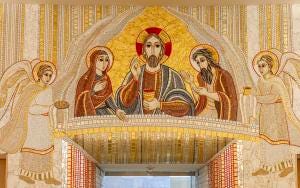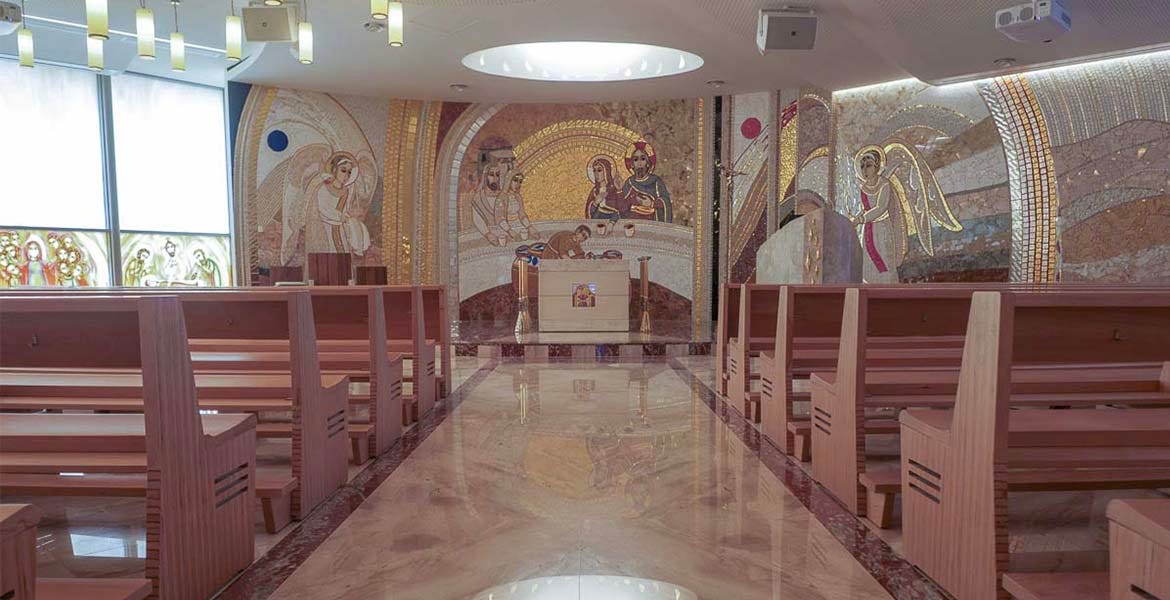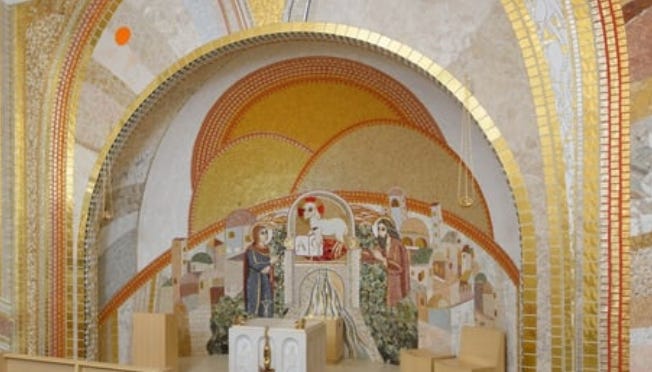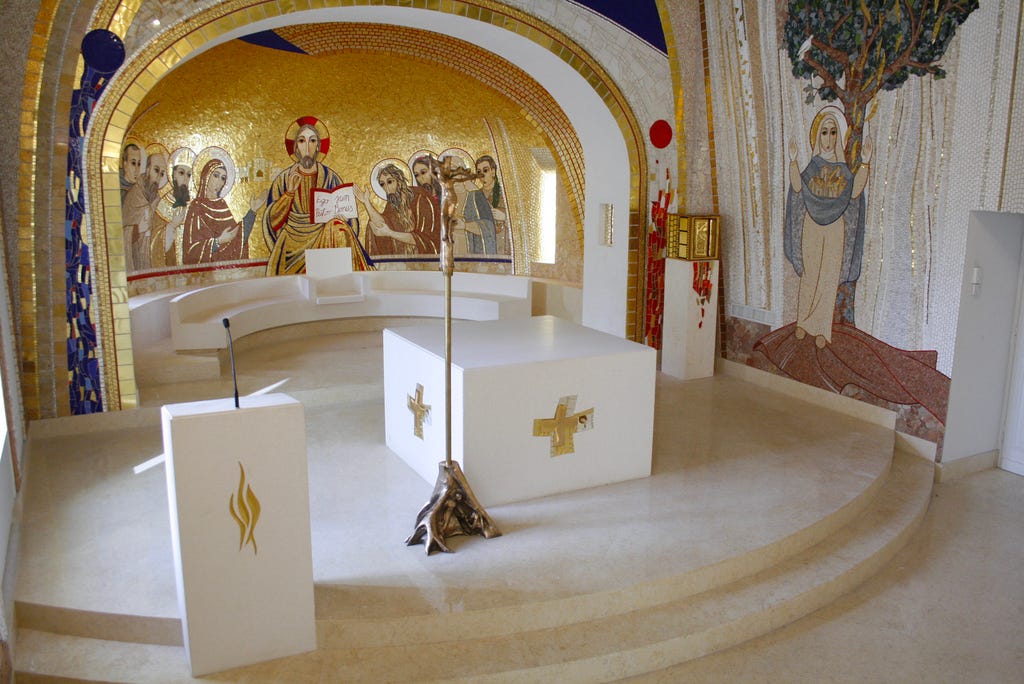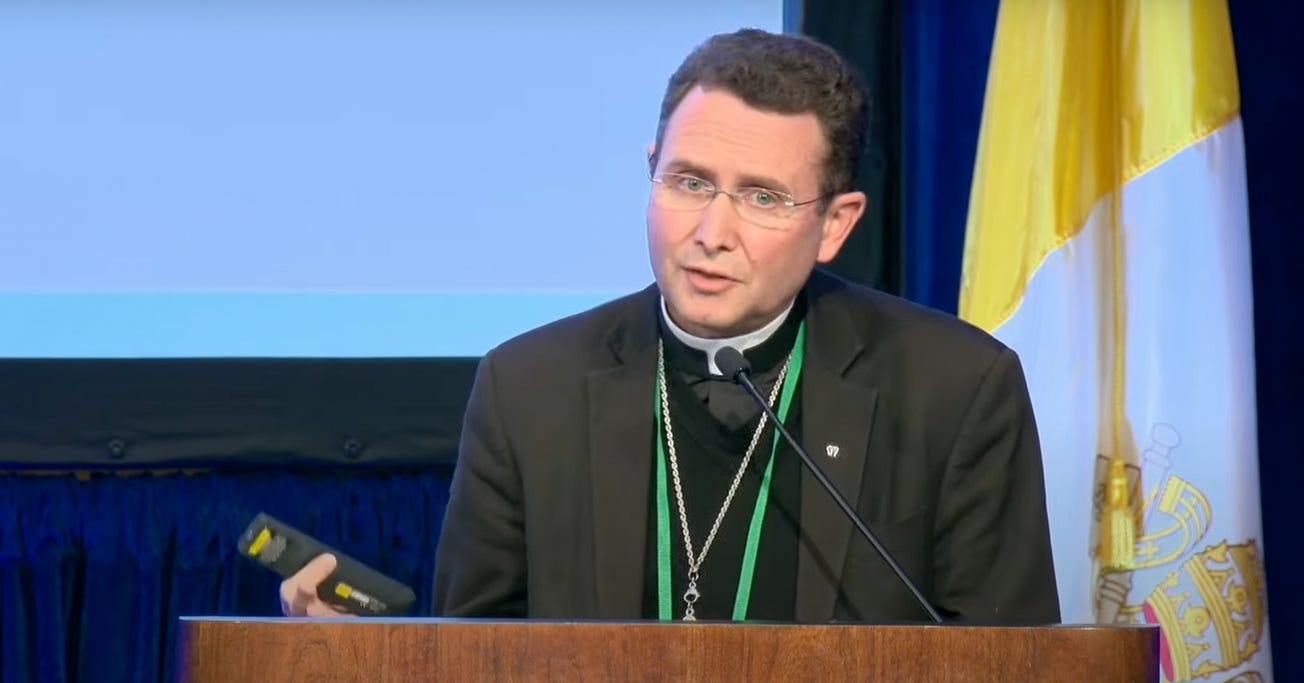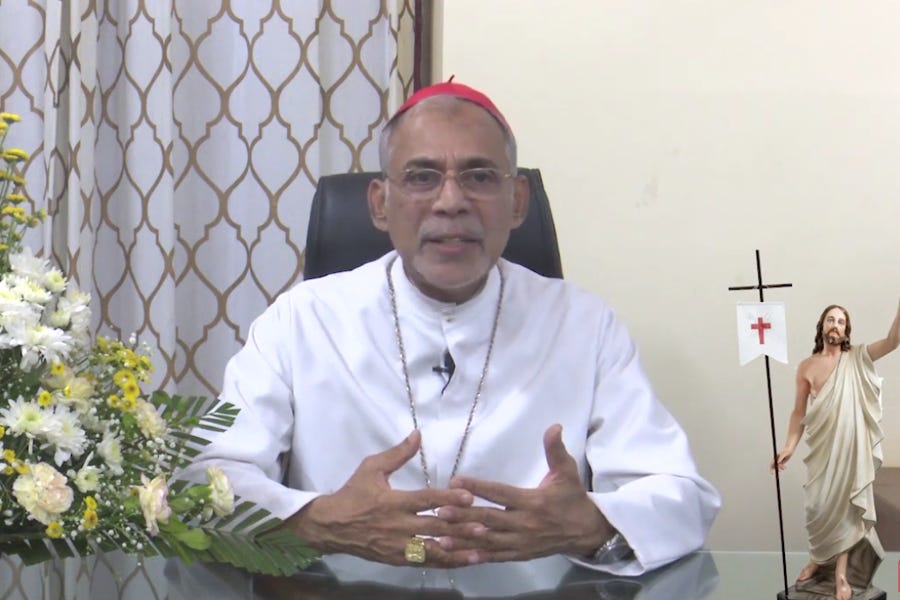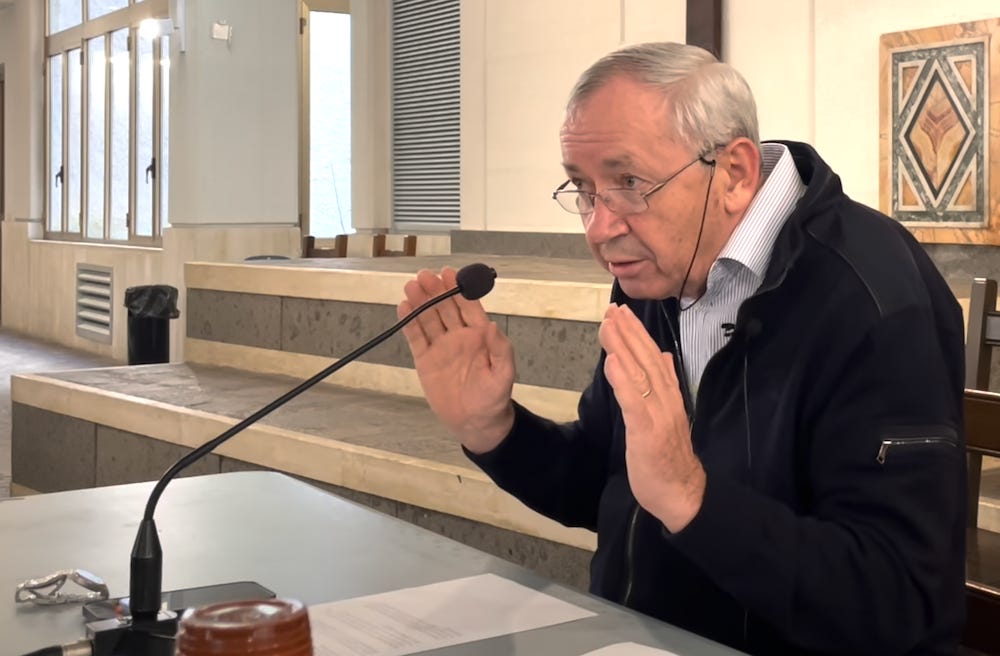
The global leader of the Jesuit order on Wednesday told journalists that Fr. Marko Ivan Rupnik, SJ, was excommunicated in 2019 — two years before he faced allegations of spiritually abusing religious sisters in the priest’s native Slovenia.
Speaking to journalists Dec. 14, Fr. Arturo Sosa, superior general of the Society of Jesus, said that Rupnik had indeed been excommunicated, but that the penalty was remitted after Rupnik - a well-known Jesuit artist - repented of a serious canonical crime, namely the absolution of an accomplice in a sin against the sixth commandment.
Sosa’s admission brings some clarity to the complicated set of allegations against Rupnik, and confusing statements issued in response to them.
But the allegations against Rupnik are still fairly complicated, and the timeline is convoluted.
In this explainer, The Pillar aims to untangle what’s happened, and what might happen next.
Who is Fr. Rupnik?
The priest is a 68-year-old Jesuit from Slovenia, who is well-known in liturgical circles, and across Europe, for his artistic work — he had installed mosaics in dozens of high-profile chapels in Europe, including one in the Vatican, and in several in the United States as well.
Rupnik is the director of the Centro Aletti, an institute founded in the 1990s at the Pontifical Oriental Institute as a center of art, theology, and culture.
Rupnik is a frequent speaker on Catholic issues in Europe, and does a weekly YouTube video explaining the Sunday readings. In 2020, the priest preached a Lenten meditation for priests working in the Vatican. He met with Pope Francis in January, and received an honorary doctorate from a Catholic university in Brazil.
Start your day with Starting Seven - a daily news roundup in your inbox.
Why is the priest in the news right now?
Italian blogs late last month began reporting that Rupnik had been accused of spiritually abusing women religious in the 1990s, members of the Loyola Community, for which the priest was chaplain. Some blogs and media sources reported that the complaints had been sent to the Dicastery for the Doctrine of the Faith.
On Dec. 2, the Society of Jesus released a statement acknowledging that complaints were sent in 2021 to the DDF, and investigated — media sources said the investigator was an auxiliary bishop in the Diocese of Rome.
The Jesuits said that in October 2022, the Dicastery for the Doctrine of the Faith decided not to pursue canonical charges against Rupnik over those abuse allegations, because the relevant statute of limitations - called prescription in canon law - had run out.
The Jesuit statement added that since the complaint was sent to Rome, the priest had been prohibited from hearing confessions, giving spiritual direction, offering the spiritual exercises, or engaging in public ministry without the permission of his religious superior.
The statement raised more questions than answers.
Journalists asked whether the DDF could have considered waiving prescription - the statute of limitations - in order to pursue a penal process against Rupnik, as it has done in other prominent abuse cases, albeit mostly involving minors.
Journalists also asked about the “restrictions” placed by the Jesuits on the priest’s ministry — he had been barred from public ministry, but gave a talk on Eucharistic adoration at the diocesan seminary in Rome, preached a 2020 Lenten meditation for the Vatican, had a meeting with the pope, released weekly videos on Scripture, and received an honorary doctorate. Furthermore, the Society of Jesus did not announce the restrictions on Rupnik’s ministry, as is usually done when priests are accused of serious misconduct.
Was he excommunicated? And what for?
While journalists raised the questions mentioned above, another issue came up.
Italian media reported that at some point, the priest had also been accused of a different canonical crime — attempting to absolve an accomplice in a sin against the sixth commandment, which means effectively having illicit sexual relations with a partner, and then hearing their confession about it.
The Church says that “the absolution of an accomplice in a sin against the sixth commandment of the Decalogue is invalid except in danger of death.”
Attempting to absolve an accomplice in a sin against the sixth commandment is regarded as a “grave delict” in the Church, which must be handled by the Dicastery for the Doctrine of the Faith. The penalty for doing so is excommunication.
The Pillar confirmed Dec. 6 that the DDF had received in 2019 an allegation of that canonical crime against Fr. Rupnik, but did not confirm how the issue was resolved.
Some Italian media reports alleged that an excommunication was declared against Rupnik, and suggested that Pope Francis was involved in remitting the penalty. The Pillar did not confirm those details.
But according to the Associated Press, Fr. Arturo Sosa, superior general of the Society of Jesus, confirmed on Dec. 14 much of those reports.
Sosa told journalists that the DDF had found Rupnik guilty of attempting to absolve a sexual partner and declared him excommunicated, and that since Rupnik had repented, the excommunication was lifted. The Associated Press reported that the attempted absolution came amid a 2015 sexual relationship, while Rupnik was living in Rome.
Despite his order’s earlier statement to the contrary, Sosa also said Dec. 14 that, in fact, Rupnik’s ministry had been “restricted” since the 2019 allegations — again, despite the fact that the restriction was never announced, and that the priest continued to engage in high-profile public activity after 2019.
Finally, Sosa said that he had not mentioned the earlier allegations against Rupnik because “they were two different moments, with two different cases.”
How does the Church handle an “absolution of an accomplice” allegation?
Great question. Such an allegation is classified as a “grave delict” in the Church, and must be handled with the involvement of the Dicastery for the Doctrine of the Faith.
This is basically how it works:
If a bishop or religious superior receives this kind of allegation against a priest, he is supposed to conduct what’s called a “preliminary investigation,” in which he should “carefully inquire personally or through another suitable person about the facts, circumstances, and imputability,” according to the Church’s canon law.
If the bishop or superior decides the allegation has “at least the semblance of truth,” he should send all the information to the Dicastery for the Doctrine of the Faith, along with a letter, called a votum, in which he assesses his sense of the case.
The DDF then has a couple of options.
It can decide the case doesn’t have merit and dismiss it.
It can order a penal process - a trial, or something like it - at the diocesan level, or it can conduct a trial or administrative process at its own offices, with its own personnel.
Or, if the facts of the case seem absolutely clear, the DDF can declare a penalty - in this case an excommunication - using something called an extrajudicial decree - which means there will be no further process.
If a penalty is declared, it can be remitted, or lifted, if a person has repented, and sufficiently addressed the scandal or harm caused by the action, or made a plan to do so.
In Rupnik’s case, there are a few possibilities:
It’s possible that the Jesuits did a preliminary investigation into the attempted absolution charge, and during that investigation, the priest admitted his guilt, and repented. If that happened, the penalty could be declared, and subsequently remitted, at practically the same time.
It is also possible that the Jesuits did a preliminary investigation and the priest did not admit his guilt. But in that case, the penalty would have been declared after some kind of process or by extrajudicial decree, and Rupnik subsequently repented sufficiently to see the DDF lift the excommunication.
In either case, by the time the new allegations of spiritual abuse had surfaced, it seems that Rupnik had repented of having had sexual contact with some person, and then of attempting to absolve them in confession.
There is no reason to think that Pope Francis would have been involved directly in any of that process — but Sosa himself said that he “could imagine” that the pope would have been informed of the issues by DDF officials, especially the Jesuit Cardinal Luis Ladaria.
That Rupnik was excommunicated in 2019 raises questions about a Vatican decision to allow Rupnik to preach in 2020 a Lenten meditation for priests working in the Roman Curia, including Pope Francis and Ladaria.
Despite the excommunication, the priest was also permitted by the Holy See to create the logo for the 2022 World Meeting of Families, organized by the Dicastery for Laity, Marriage, Family Life, and Youth. While Rupnik was ostensibly facing restrictions on his ministry, he was featured in videos and other promotional material promoted by the dicastery, raising questions about how Vatican officials - including Pope Francis - responded to the sanctions and restrictions placed on Rupnik.
What exactly is an excommunication?
Despite popular perception, excommunication does not mean that a person is “kicked out” of the Church.
Instead, excommunication is a legal penalty which prohibits a person from offering Mass and other sacraments, if ordained, from receiving the sacraments, from celebrating or participating in liturgical ceremonies, from holding official offices, ministries, or functions in the Church, or from performing acts of governance.
To have those effects, the excommunication must be imposed or declared by a competent authority, who can also remit the penalty if the excommunicated person has repented of his wrongdoing, and satisfied any other established conditions.
This is a lot, what’s the TL;DR? And what will happen next?
It is a lot.
Here’s a summary of what’s known:
Fr. Rupnik has been accused of at least two different issues: attempting to absolve a person with whom he had sexual contact, and spiritually abusing a community of consecrated women. He was excommunicated for the attempted absolution in 2019, and at some point thereafter that penalty was lifted.
In 2022, the DDF reportedly declined to pursue canonical charges related to the spiritual abuse, owing to the canonical statute of limitations.
While the Jesuits have given different accounts at different times, they now say that Rupnik's public ministry has been restricted since 2019 — but that restriction has never been announced, and the priest has continued with numerous ministerial activities, including permission to preach a Vatican Lenten meditation the year after his excommunication.
As to what will happen next, it seems unlikely that Rupnik’s reputation will be rehabilitated, and while the DDF declined a canonical process, it is now known publicly that the priest has faced multiple allegations of sexual misconduct. That suggests he will probably not continue with a public presence and ministry.
But attention has now shifted to the Jesuits themselves, with journalists asking questions about why the order has given different accounts at different times, dependent upon how much information has been uncovered in the media.
Questions are also being asked about the alleged restrictions on Rupnik’s ministry, given his public profile. It is possible that Sosa or other Jesuit superiors could face Vos estis lux mundi allegations, if they are believed to have mishandled elements of the allegations against Rupnik.
Given the attention being paid to the case, it seems unlikely journalists will quickly drop the issues, which could put pressure on the Vatican to pursue an investigation into how the Jesuits have handled the case.
What’s the deal with Rupnik’s art?
That’s a good question.
The priest has designed mosaics for dozens of contemporary European churches, including for a prominent shrine to Pope St. John Paul II in Krakow, and for a chapel inside Vatican City.
He designed the official logo of 2022’s World Meeting of Families.
He also designed the mosaics of the chapel at the John Paul II shrine in Washington, DC:
And he designed the Knights of Columbus chapel in Connecticut, as well as a chapel at Sacred Heart University and several other sacred spaces in the United States.
There is a particular element of Rupnik’s mosaic style that has captured The Pillar’s curiosity. Many of his mosaics include the presence of a large colored circle in one of the upper corners.
See if you can spot those colored discs in these examples:
The Pillar asked Centro Aletti about the significance of those discs.
A spokesperson told The Pillar by email that “there is not a unique meaning itself. It has a value of ‘reading aid,’ as a counterpoint or as a balance of forms.”
“The circle therefore recalls the symbol of divinity, which has no beginning and no end. Also [the] colors do not have a unique meaning. Usually red is for divinity and blue for humanity.”
The Pillar asked for clarity on what it means for the discs to serve as a “reading aid,” but the Centro Aletti has not yet responded.
Anyway, we here at The Pillar found them interesting! (Mostly just JD, actually.)


